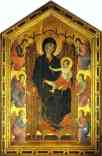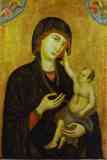Duccio di Buoninsegna Biography
The great age of the Sienese School started with Duccio. Neither contemporary accounts of him nor any personally written documents have come down to us. Though there are many records for Duccio in municipal archives: records of changing of address, payments, civil penalties and contracts, which help to get an idea of the life of the painter.
Although as a young man Duccio probably worked in Assisi, he spent virtually his entire life in Siena. Duccio is first mentioned in Sienese documents in 1278 in connection with commissions for 12 wooden panels for the covers of the municipal books. In 1285, a lay brotherhood in Florence commissioned him to complete an altarpiece for the church of Santa Maria Novella. This masterpiece is known now as the Rusellai Madonna. By that date he must already have had a name, which guaranteed a high quality of work.
At the beginning of the 14th century Siena was competing with its neighbor, Florence, for political and artistic supremacy in central Italy. Duccio seems to have played an important role in this period of economic and artistic expansion in Siena. In 1295, along with other masters from the cathedral stonemasons’ lodge, he was appointed to a special committee that was to decide where a new fountain should be installed. Seven years later, in 1302, he received payments for an altarpiece with a predella – now lost – which he was due to paint for a chapel in the Palazzo Publico, the seat of the municipal government.
Finally, his most significant commission for the city was the new monumental picture of the Madonna for the cathedral’s high altar, the Maestà. The surviving contract from 1308, as well as various payment records for 1311, documents the creation and installation of this work.
The last entry on Duccio in the municipal archives is dated October 1319. In it his seven children declare that they are foregoing their inheritance in favor of their mother. This means that their father must have died in 1318 or 1319.
Today nine or ten works definitely by Duccio’s hand are known. They are: the Crevoli Madonna (1280), the Madonna of the Franciscans (1300), Madonna in the Galleria Nazionale of Perugia, the Maestà (1308-1311), the Rucellai Madonna (1285), a Madonna in a private collection in Brussels, two altarpieces in the Pinacoteca Nazionale of Siena, The Holy Virgin with the Christ Child and Four Saints (1300); and two triptychs, one in the National Gallery in London, The Holy Virgin and the Christ Child with St. Dominic and St. Aurea (1300), and one in the Museum of Fine Arts in Boston.
A faithful follower of Byzantine painting, Duccio managed to give to his traditionally painted figures fresh humanity and life with his newfound sensitivity to color and line. The delicate Virgins in Perugia, London, and also Siena provide wonderful examples of Duccio’s poetic rendering of feeling.
While his paintings may seem rooted in the Byzantine tradition, one can distinguish the first signs of the International Gothic art that was to influence Simone Martini and the Lorenzetti brothers.
Bibliography
The Art of the Italian Renaissance. Architecture. Sculpture. Painting. Drawing. Könemann. 1995.
Painting of Europe. XIII-XX centuries. Encyclopedic Dictionary. Moscow. Iskusstvo. 1999.
Duccio (Masters of Italian Art Series) by Andrea Weber. Konemann, 1998.
Duccio: The Maesta by Luciano Bellosi, Duccio. Thames & Hudson, 1999.
Duccio Di Buoninsegna: The Documents by Jane Satkowski, Hayden B. J. Maginnis. Georgia Museum of Art, 2000.
- Rucellai Madonna.

c.1285. Tempera on wood. Galleria degli Uffizi, Florence, Italy. Deposited in the Church Santa Maria Novella, Florence, Italy.
- Crevole Madonna.

c.1280. Tempera on wood. Museo dell'Opera del Duomo, Siena, Italy.
- Madonna Of The Franciscans.

c.1300. Tempera on wood. Pinacoteca Nazionale, Siena, Italy.